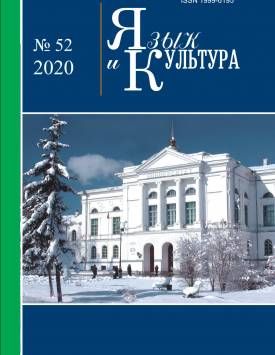Current State of Traditional Linguoculture of the Germans of Tomsk Region
This article is devoted to the language of Russian Germans - a subethnos embraced by the processes of linguistic and cultural shift. The work was carried out in the mainstream of Russian German dialectology, its methodological base combines the approaches of field linguistics, sociolinguistics and discursive linguistics. The purpose of the work is to present the current state of the traditional linguoculture of the Germans of Tomsk region through a description of the communicative power of its constituent language formations. Communicative (functionality) power is further understood as the “weight” of the language in the social structure, determined by the variety of its possibilities to act as a communication tool within this structure. As a result of the study, for the first time, a model of the sociocommunicative system of the Germans in the region is constructed. within the model are demonstrated the functional limits determined by discourses and typical speech-behavioral situations of each of the components of the system. The factual data of the study were collected by the author of the article in the field, mainly in rural areas of Tomsk region. 123 speakers of the linguistic formations traditional for the considered linguoculture - German dialects were interviewed. The reference group also includes the Germans of the region who have completely lost their sub-ethnic linguocultural properties. As a result of the study, it was established that, due to the dominant position of Russians, assimilation is a permanent property of the Germans in the region: the linguocultural continuum is subjected to gradual narrowing and leveling under the influence of the Russian language. However, monogolosity does not apply to the entire socio-communicative system of the considered ethno-territorial group. Acting as the most functionally active language of the system at individual levels of its discursive hierarchy, it shares the total volume of the communicative load with other linguistic formations of both majoritarian and minority statuses. Minority includes German dialect-colored literary language and German dialects of a predominantly Midwestern type. The sphere of existence of the dialect-colored version of the German literary language is formed mainly by precedent texts of religious, folklore-song and folklore-comic discourses. The communicative power of German dialects is limited by the framework of everyday discourse, they are especially functional at the micro level of the social structure - in intrafamily communication. German dialects co-function in everyday discourse along with the Russian language, therefore, the variables that determine the situational structure of the dialect use (the speaker's intentions, the type of addressee, his code repertoire, the nature of the situation, etc.) have greater weight than social ones. From a methodological perspective, the study demonstrates that the description of the state of shifted languages from the standpoint of discourse analysis gives the most complete and detailed picture of this state.
Keywords
Russian Germans, dialectology, linguistic shift, “small” linguoculture, communicative power, discourseAuthors
| Name | Organization | |
| Aleksandrov Oleg A. | Tomsk State University | olegaleksandrov79@gmail.com |
References

Current State of Traditional Linguoculture of the Germans of Tomsk Region | Yazyk i Kultura – Language and Culture. 2020. № 52. DOI: 10.17223/19996195/52/1
